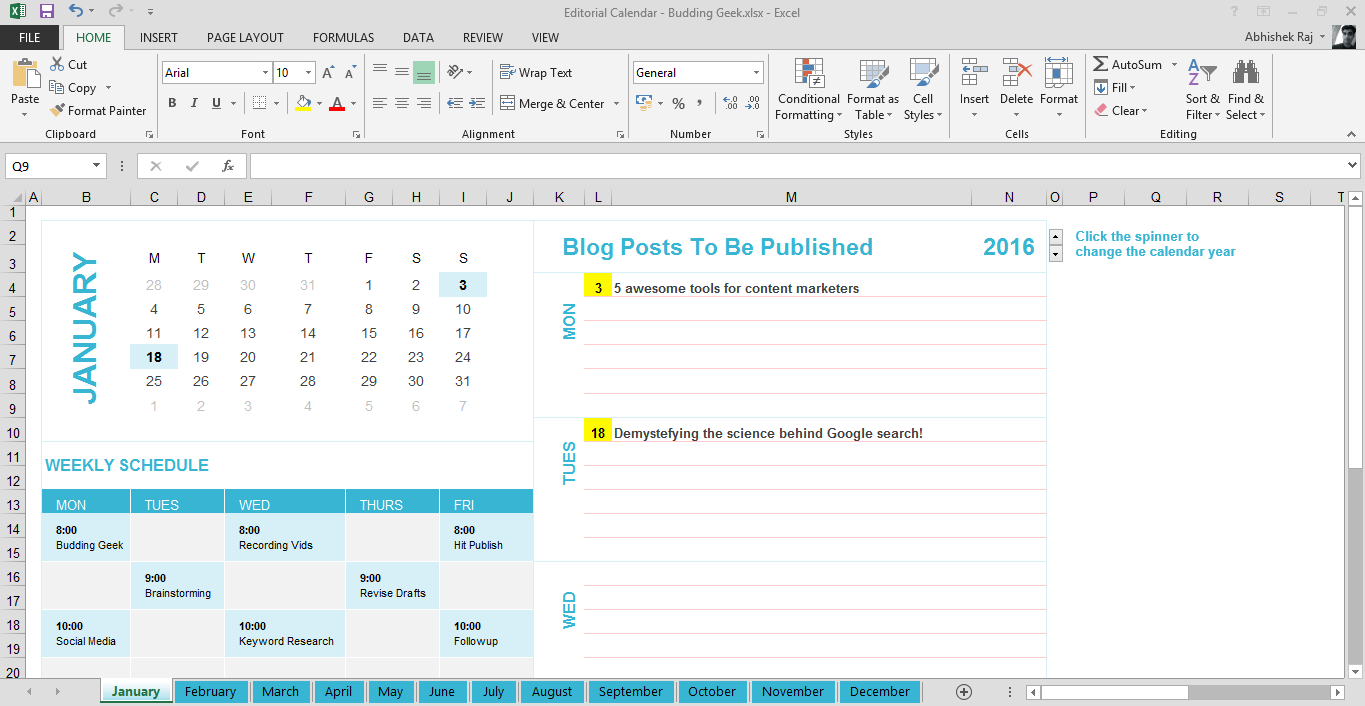Blogging for business is hard. Not only do you have to research, write and rewrite each post to near-perfection, you also have to send them out into the world. And when you do that on a daily, weekly or monthly basis, you can burn out in no time.
To stave off burn out, you need an editorial calendar. With it, you can plan posts ahead, schedule time-consuming tasks and increase your productivity. And creating that calendar is easier if you use one or more of the following tools:
1) CoSchedule
Manually sharing blog posts across multiple social networks can be time-consuming. When you use CoSchedule, however, you can set when and where to share your posts. For example, if your “Ultimate Guide to Everything” is posted on Monday, you can set CoSchedule to share it on Tuesday, and again on Friday.
Of course, that’s not all CoSchedule can do. It also integrates smoothly with popular publishing platforms (WordPress, Google Docs, Evernote) and social networking sites (LinkedIn, Twitter), so your content marketing will be even less of a hassle.
2) Divvy HQ
If you’re juggling several blogs at once, you might want to use Divvy HQ. It allows you to create multiple calendars, which can be color-coded for your convenience. You can also filter posts according to who’s working on which, so you’ll always stay on top of the tasks.
Divvy HQ has a feature called “Parking Lot,” which lets your team store content ideas as they come along. It also has workflow tracking, team management and other features you’d expect from a top-notch content planning tool. If efficiency is a problem in your team, Divvy HQ might just help you ramp things up.
3) Gather Content
Have you ever accidentally published the first draft rather than the final draft of a post? Even if you haven’t, Gather Content can still help you organize content: It allows you to edit and review posts on the cloud, eliminating the need to constantly swap Word documents.
Gather Content has other features that speed up the editorial process. There’s the content style guide generator, the status tracker and the import-export function, among others. All of them ensure that you maintain a high-volume production of quality content.
4) Kanbanize
Even the best bloggers can get overwhelmed. When you have multiple research-heavy blog posts, for instance, you’ll have to track sub-tasks like “Write interview questionnaire for John Doe” and “Create pie chart.” That’s where Kanbanize comes in.
Kanbanize has a Card Links feature, which can group small tasks under a larger umbrella task and set “life cycles” for each of them. This way, it’s easier to identify which tasks matter, and which ones can be eliminated from or pushed down on the priority list. Also, Kanbanize has an IFTT (If This, Then That) feature, e-mail integration, time-tracking and analytics to complement your content strategy.
5) Kapost
Kapost is one of the more comprehensive tools on this list. With its tabs for “Content,” “Calendar,” “Campaigns,” “Analytics” and “Audience,” it offers a bird’s-eye view of every stage of the content marketing process. Kapost has a similar look and feel to Google’s Calendar and Drive services, so you’ll find your way around it in no time.
6) Microsoft Excel
Excel is more of an analytical than a planning tool. But if you prefer to design your editorial calendar from scratch, this one will do. You can also pull from Excel’s many calendar templates, and build your schedule from there.
7) Trello
If there’s one word that sums up Trello, it’s “flexible.” With its card system, you can organize tasks however you like. You can arrange the cards according to due date, label and/or person responsible, and even add comments to them. The only limit to this tool is your imagination. And, did I mention that it’s free? 🙂
8) Edit Flow
The Edit Flow Plugin from WordPress lets you create a posting schedule, drag and drop posts between dates and sync with Google Calendar. If you want to track the progress of every piece of content, all you have to do is set up a custom status report for everyone. For a free tool, Edit Flow has a nice set of features.
Pick Your Favorite Time Management Tools!
So there you have it: The eight best tools to plan out your content. If you’ve used any of these, or if you know of similar tools that are just as awesome, let’s talk about them in the comments.
[su_note note_color=”#ffff8c” text_color=”#000000″]This guest post has been written by Kayla Matthews, a tech fanatic blogger who runs ProductivityBytes.com. Follow her on Twitter to read all of her latest posts![/su_note]






What a great list of time management tools! Thank you guys 🙂
You’re welcome Meg. Glad that you found the post useful 🙂
Hey Kayla !! beautifully written and u’ve mentioned some of the very useful tools. Keep going!! 🙂
Thanks so much! I hope they make life a little easier for you! =)
Great List kayla. Coschedule is my favourite tool if you ask me choose one from this list. Otherwise, Evernote is the tool that has impressed me way more than any other tool.
Still a great list.I Haven’t tried Trello yet. Will try for sure.
Thanks, Puneet! It was a super fun list to create! And yes – If you haven’t tried Trello yet I’m really interested to hear what you think of it. Let me know!
Awesome post and very well illustrated. I think Any.do is worth mentioning on this list. I plan my editorial calendar and collaborate with my team a lot using Any.do!
Hi Nimi! Thanks so much for the suggestion! I’ll keep your recommendation in mind. Thanks for reading!
Hi Kayla. Awesome post 🙂 Trello really impressed me. I also love to use Evernote to boost my productivity. It has been my all time favorite. It lets me write posts on my mobile/tablet while I’m away, and syncs them seamlessly across all my devices. Edit flow also seems interesting. Will definitely try it out! 🙂
You seem like you have your productivity pretty well figured out! I’m glad Evernote works so well for you! =)